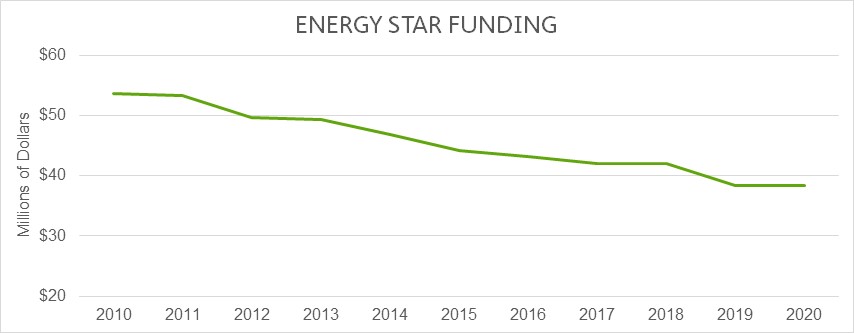Doubling ENERGY STAR: Reducing Energy Bills, Cutting Emissions, and Driving Economic Growth
ENERGY STAR is among the most popular and effective public-private partnerships in the federal government. Nine out of 10 people recognize its trademark logo, and nearly two-thirds of consumers say it has influenced their purchasing. It saves consumers and businesses more than $39 billion in avoided energy costs annually and sharply reduces greenhouse gas emissions – all with a budget of less than $39 million. In fact, the 330 million metric tons of greenhouse gas (GHG) emissions avoided by ENERGY STAR in 2018 are roughly equivalent to 5% of the nation’s total emissions. Despite this success, ENERGY STAR’s capacity has shrunk in recent years due to a steady erosion of funding.
Reversing this trend and expanding ENERGY STAR funding is a foundational step in meeting the Biden administration’s goal of reducing greenhouse gas emissions 50% by 2030 while lowering energy costs for households in the face of rising prices. ENERGY STAR delivers incredible bang for its buck – delivering an astounding $350 in energy cost savings to Americans for every $1 invested by the government – but that buck cannot afford to be getting smaller and smaller at a time when economic and environmental needs demand a doubling down on all the tools we’ve got. To meet this moment, we’re calling for a doubling of this budget to at least $80 million annually.

ENERGY STAR funding has decreased from $54 million a decade ago to just $38 million today. Merely adjusting for inflation would have required a $62 million budget. These cuts have limited ENERGY STAR’s ability to keep up with fast-moving technology and expand its work in sectors where large energy savings have yet to be tapped, particularly homes and buildings.
Doubling ENERGY STAR funding to $80 million would not only ensure that ENERGY STAR continues to produce independent, objective, and reliable information, but that it can expand programs to meet the climate imperative and ensure all households have access to the benefits of energy efficiency. Among other impacts, increased funding could deliver greater resources and technical assistance for the Portfolio Manager program that states and cities across the country rely on to benchmark commercial building energy use; improved partnerships with utilities and local governments that rely on ENERGY STAR for efficiency programs nationwide; an expansion of covered product categories; and strengthened ENERGY STAR programs for new home construction and home retrofits.
Proven Impact
- 3 metric tons of GHGs have been avoided for each dollar invested by the Environmental Protection Agency (EPA) in ENERGY STAR. More than 4 billion tons of GHGs total have been avoided since 1992 – equivalent to the annual emissions of 870 million automobiles.
- Pollution and emissions avoided in 2019 contributed between $7-17 billion in public health benefits.
- American households and businesses saved $39 billion on energy costs through ENERGY STAR in 2019 alone. Every $1 invested by EPA on ENERGY STAR results in $350 in energy cost savings.
- More than 800,000 Americans are employed in manufacturing or installing ENERGY STAR-certified appliances. The estimated annual market value of ENERGY STAR product sales is more than $100 billion.
- Americans purchased more than 300 million ENERGY STAR-certified products in 2019, with two-thirds of U.S. households knowingly purchasing an ENERGY STAR product. The program boasts national brand recognition above 90%.
INCREASING RESPONSIBILITIES
While ENERGY STAR funding has steadily decreased over the last decade, the responsibilities of the program have continued to grow, including:
- Introducing at least 14 new ENERGY STAR product categories, including data centers, commercial water heaters, and EV chargers.
- Updating ENERGY STAR product requirements for 82 product categories.
- Adding water use, waste, and materials tracking features to the ENERGY STAR Portfolio Manager.
- Initiating a national call-to-action to change 300 million light bulbs.
- Introducing the ENERGY STAR “Most Efficient” product designation.
- Creating a recognition program for energy-efficient tenant spaces.
- Partnering with 40% of Fortune 500 companies to improve their energy management.
WHY EXPAND ENERGY STAR FUNDING?
- Increased funding would enable ENERGY STAR to better track, measure and benchmark commercial building energy use. ENERGY STAR Portfolio Manager is the foundation for the fast-growing movement toward energy benchmarking and transparency for commercial buildings, with 34 local governments and three states adopting policies relying on the tool. In 2019 alone, more than 275,000 buildings – equal to 25% of U.S. floorspace– used Portfolio Manager to measure and track their energy and water use. With sufficient funding, the program could provide critical resources and technical support to states, local governments, and building owners while expanding to cover more building types. ENERGY STAR’s tenant spaces program will help address the split-incentive barrier for office tenants.
- Increased funding would bolster the ENERGY STAR residential energy efficiency programs. ENERGY STAR certified homes achieve average energy savings of 20% compared to typical new homes. Additional resources would allow ENERGY STAR to expand its residential new construction and existing home retrofit programs, creating a strong national brand driving the market toward more energy-efficient homes.
- Increased funding could strengthen the consumer products program by adding more product categories and expanding and better marketing the ENERGY STAR “Most Efficient” initiative. ENERGY STAR must keep up with fast-moving markets to cover energy-intensive products as they evolve. Also, in product categories where a high percentage of available products already meet standard ENERGY STAR performance, highlighting best-in-class products can help drive deeper efficiency gains.
- Increased funding could support streamlined and updated methods for tracking energy-saving performance data within the federal government. Better tracking of federal energy use can save time and reduce redundant government spending.
